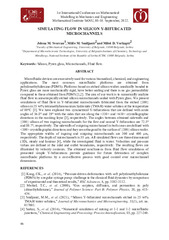Приказ основних података о документу
Simulating flow in silicon Y-bifurcated microchannels
| dc.creator | Svorcan, Jelena | |
| dc.creator | Smiljanić, Milče | |
| dc.creator | Vorkapić, Miloš | |
| dc.date.accessioned | 2023-02-09T19:00:02Z | |
| dc.date.available | 2023-02-09T19:00:02Z | |
| dc.date.issued | 2022 | |
| dc.identifier.isbn | 978-86-6060-127-0 | |
| dc.identifier.uri | https://machinery.mas.bg.ac.rs/handle/123456789/4261 | |
| dc.description.abstract | Microfluidic devices are excessively used for various biomedical, chemical, and engineering applications. The most common microfluidic platforms are obtained from polydimethylsiloxane (PDMS). Platforms based on etched silicon wafers anodically bonded to Pyrex glass are more mechanically rigid, have better sealing and there is no gas permeability compared to those obtained from PDMS [1,2]. The aim of our work is to numerically analyze fluid flow in anisotropically etched silicon microchannels sealed with Pyrex glass. We present simulations of fluid flow in Y-bifurcated microchannels fabricated from the etched {100} silicon in 25 wt% tetramethylammonium hydroxide (TMAH) water solution at the temperature of 80°C [3]. We have explored two symmetrical Y-bifurcations that are defined with acute angles of 36.8° and 19° with the sides that are along the <310> and <610> crystallographic directions in the masking layer [3], respectively. The angles between obtained sidewalls and {100} silicon of two ingoing microchannels for the first and second Y-bifurcation are 72.5° and 80.7°, respectively. The sidewalls of outgoing microchannel in both cases are defined with <100> crystallographic directions and they are orthogonal to the surface of {100} silicon wafer. The appropriate widths of ingoing and outgoing microchannels are 300 and 400 μm, respectively. The depth of microchannels is 55 μm. All simulated flows are three-dimensional (3D), steady and laminar [4], while the investigated fluid is water. Velocities and pressure values are defined at the inlet and outlet boundaries, respectively. The resulting flows are illustrated by velocity contours. The obtained conclusions from fluid flow simulations of presented simple Y-bifurcations provide guidance for future fabrication of complex microfluidic platforms by a cost-effective process with good control over microchannel dimensions. | sr |
| dc.language.iso | en | sr |
| dc.publisher | University of Belgrade, Faculty of Mechanical Engineering | sr |
| dc.rights | openAccess | sr |
| dc.rights.uri | https://creativecommons.org/licenses/by/4.0/ | |
| dc.source | Booklet of Abstracts - 1st International Conference on Mathematical Modelling in Mechanics and Engineering | sr |
| dc.subject | Silicon | sr |
| dc.subject | Pyrex glass | sr |
| dc.subject | Microchannels | sr |
| dc.subject | Fluid flow | sr |
| dc.title | Simulating flow in silicon Y-bifurcated microchannels | sr |
| dc.type | conferenceObject | sr |
| dc.rights.license | BY | sr |
| dc.citation.rank | M34 | |
| dc.citation.spage | 46 | |
| dc.identifier.fulltext | http://machinery.mas.bg.ac.rs/bitstream/id/10021/bitstream_10021.pdf | |
| dc.identifier.rcub | https://hdl.handle.net/21.15107/rcub_machinery_4261 | |
| dc.type.version | publishedVersion | sr |


